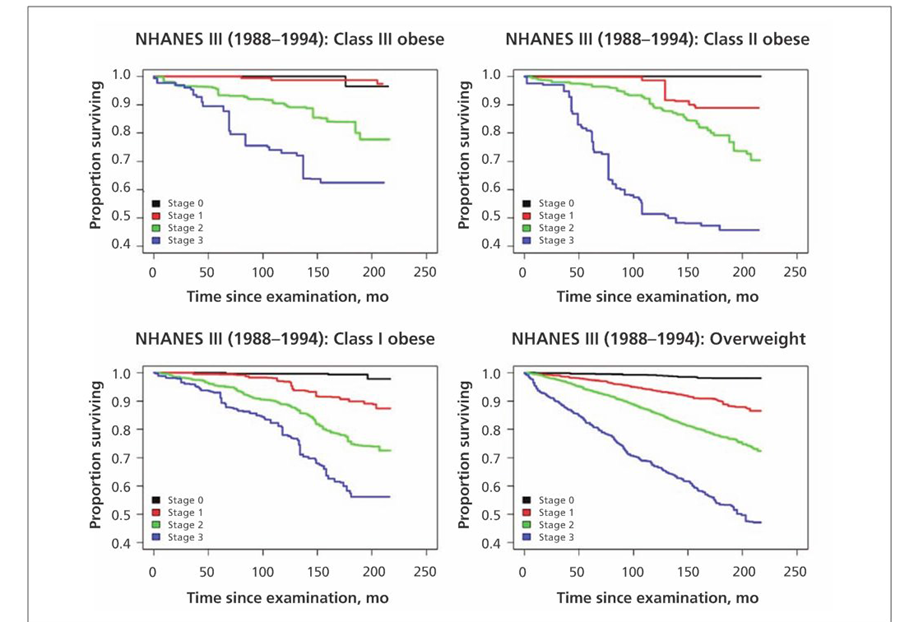One of great paradoxes of our obesity epidemic is that many obese individuals appear to be quite healthy. This makes the true believers in the Holy Grail of BMI as the standard for good health quite livid. They know in their hearts that obesity is a mortal sin. Early this year the Centers for Disease Control (CDC) published another in a long series of articles demonstrating that being overweight significantly decreases your likelihood of dying compared to being “normal weight” (1). Immediately Harvard Medical School went on a rampage crying foul. So you can imagine the delight of the weight-loss experts when a new meta-analysis demonstrated that “there is no healthy pattern of increased weight” (2). Take that, you silly scientists at the CDC. Unfortunately, this article represents another case of a meta-analysis creating meta-confusion.
When you state that someone is metabolically healthy obese, it means just that—they are healthy. So how can you look at someone and say they are healthy? You have to look for accepted signs of health, not whether or not they fit into designer clothing. Fortunately, there is a health ranking of obese individuals that is not based on their actual weight. It is called the Edmonton Obesity Staging System (EOSS). Obviously to be included in this ranking system, an individual has to be obese (BMI > 30). But now they are ranked in terms of health as shown below:
Stage 0: Normal blood pressure, blood glucose, and blood lipid levels and no physical or psychological impairment to being obese.
Stage 1: Existence of subclinical risk, such as borderline hypertension, impaired fasting glucose, elevated liver enzymes, mild physical symptoms, and mild impairment of well-being.
Stage 2: Established chronic disease (hypertension, type 2 diabetes, sleep apnea, osteoarthritis, etc.) and moderate limitations in physical and psychological well-being.
Stage 3: Established end-organ damage (heart attack, stroke, heart failure, etc.) and significant physical and psychological impairment.
Stage 4: Essentially the walking dead.
My definition of a healthy obese individual is someone who has an EOSS Stage 0 ranking.
So using these EOSS definitions and the NHANES III data from 1988-1994, how many people with excess weight are actually healthy using the standard definitions of excess weight: Overweight being a BMI of 25-30, Grade 1 Obesity having a BMI between 30-35, Grade 2 Obesity having a BMI between 35-40, and Grade 3 Obesity having a BMI > 40?
| Overweight | Obese 1 | Obese 2 | Obese 3 | |
|---|---|---|---|---|
| U.S. Population | 50M | 23M | 10M | 6M |
| Stage 0 | 15% | 8% | 5% | 5% |
| Stage 1 | 28% | 19% | 17% | 10% |
| Stage 2 | 47% | 59% | 64% | 67% |
| Stage 3 | 10% | 14% | 14% | 14% |
The total number of overweight and obese Americans falling within the four rankings of EOSS accounted for nearly 90 million Americans. You can also see that there is great heterogeneity within each category of excess weight, but between 5 to 8% of obese patients are quite healthy regardless of their weight.
If you have an EOSS Stage 0 ranking regardless of your weight, you are healthy. Obviously, the more things wrong with you health-wise regardless of your weight, the more likely you are to going to have even more health problems in the future.
And here is the problem with the article that generated so much glee at Harvard Medical School—the researchers didn’t distinguish between truly healthy obese (EOSS Stage 0) and not-so-healthy obese (EOSS Stage 1). In fact, 9 of the 12 studies they included for their meta-analysis defined being “healthy” as not having metabolic syndrome (2). To have metabolic syndrome requires having three very different unhealthy factors. The other 3 studies included defined “healthy” as having two or less risk factors for metabolic syndrome. This means someone with hypertension, elevated blood glucose, or elevated triglycerides would be considered “healthy” in this meta-analysis (2). I guess I come from the old school, in that I wouldn’t consider such people healthy.
Now if you go back to the earlier study published by the CDC, these researchers used a very simple clinical end point that can’t be fudged (1). This end point is called death. Their data clearly points out that overweight people had a significantly a lower death rate than normal-weight people. That’s a hard fact. And the Grade 1 Obese individuals have about the same death rate as normal-weight individuals. If the CDC had used the EOSS system instead of relying on BMI, then it is likely that every grade of obese person with an EOSS Stage 0 would be living longer than normal-weight individuals.
Another recent study has indicated that metabolically healthy obesity (again using mixed patient populations) may be a transitory stage (4). However that study also used a combination of EOSS Stage 0 and Stage 1 patients within their definition of “metabolically healthy obese”. When you separate the truly healthy obese (EOSS Stage 0) from the not-so-healthy (EOSS Stage 1), you find that EOSS Stage 0 patients (regardless of their levels of obesity) maintain their health over a long time period (more than 16 years) as shown below (3).

The EOSS Stage 1 individuals in all weight classes become progressively less healthy with time. So if you combine the truly healthy obese (EOSS Stage 0) with not so healthy obese (EOSS Stage 1), then you might come to the wrong conclusion that the concept of metabolically healthy obesity doesn’t exist (2,4).
So what’s the real linkage between weight and mortality? It depends on your levels of cellular inflammation as I explained in my book Toxic Fat, published in 2008. And the less cellular inflammation you have at any weight, the healthier you are. The best measure of your levels of cellular inflammation is the AA/EPA ratio. It should be between 1.5 and 3. The average AA/EPA ratio for Americans is about 19 (5). As you reduce cellular inflammation, the severities of all forms of chronic disease are reduced regardless of your weight.
References:
- Flegal KM, Kit BK, Orpana H, and Graubard BI. “Association of all-cause mortality with overweight and obesity using standard body mass index categories: a systematic review and meta-analysis.” JAMA 309:71-82 (2013).
- Kramer CK, Zinman B, and Renakeran R. “Are metabolically healthy overweight and obesity benign conditions?” Annals of Internal Medicine 159: 758-769 (2013).
- Padwal RS, Pajewshi NM, Allison DB, and Sarma AM. “Using the Edmonton obesity staging system to predict mortality in a population-representative cohort of people with overweight and obesity.” Can Med Assoc Journal 183:E1059-E1065 (2011).
- Appleton SL, Seaborn CJ, Visvanathan R, Hill CL, Gill TK, Taylor AW, and Adams RJ. “Diabetes and cardiovascular disease outcome in the metabolically healthy obese phenotype.” Diabetes Care 36:2388-294 (2013).
- Harris WS, Pottala JV, Varvel SA, Borowski JJ, Ward JN, and McConnell JP. “Erythrocyte omega-3 fatty acids increase and linoleic acid decreases with age: observations from 160,000 patients.” Prostaglandins Leukot Essent Fatty Acids 88:257-263 (2013).






Let Us Know What You Thought about this Post.
Put your Comment Below.